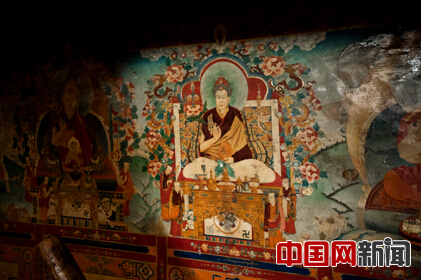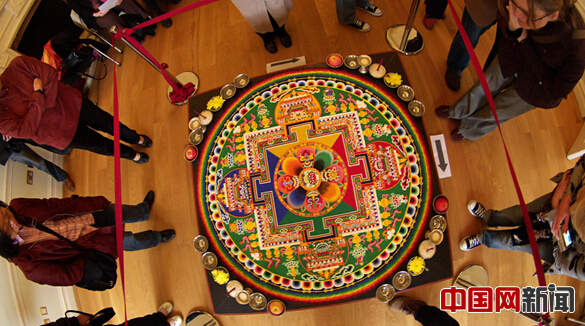Tibet's secret temple exhibited in London
On January 16, monks from Tashilhunpo Monasteryin Tibet, will create Medicinal Buddha themed Mandala sand paintings with colorful sands at the Wellcome Collection Museum, the whole creative process will continue for a week, ending on January the 23rd.
Near the London Euston city district railway station, there is a not so well-known private museum called the Wellcome Collection. Its outer appearance and neoclassical buildings are typical, but within it is a vast universe. The museum has been self-proclaimed as a place for "persons of bursting curiosity, and as an open door free visit and venture into," and was founded by Sir Henry Wellcome Jesuit (1853-1936). This Jesuit was a legendary early 20th century figure that defined the times, he was born in the American West during the Pioneering Period, yet ultimately through outstanding contributions in various fields including business, medicine, and charity collections etc. he achieved the high title of British knighthood.
The exhibition is titled "Tibet’s Secret Temple", it will have the aim of revealing the mysteries of esoteric Buddhism. Through display of more than 120 pieces collected from around the world, it will show the rich history of Tibetan Buddhism through aspects of yoga and meditation practice. The exhibition was inspired by a series of intricate murals embedded throughout the Lu Kang Temple in Lhasa, Tibet. From adders to fabrics, musical instruments, Buddhist statues, paintings, scrolls, architectural models, archived photography and modern photographic portraits, a wide variety of exhibitions narrate and tell the story of what was once specially used by the Dalai Lamas in the Kang Lu Temple.
In order to lead the audience into the theme, dual-screen video works of the "Lu Kang Temple" produced by David Pikistov and shot in 2015 will be displayed in the first portion of the exhibition. This temple, in Tibetan language, translates to "gateway to the snake spirit temple" andwas built in the late 17th century. It had once belonged to the 5th and 6th Dalai Lama, a place for the most holy ones to engage in private meditation practice, and it was also a well kept secret located behind the Potala Palace, which could only be reached by paddling a small boat, almost completely isolated from the world. In the uppermost reaches of the temple are murals rich in content, painted thereat to help guide the Dalai Lama and his closest on the path to attain enlightenment through meditation practice, and thanks to re-creations made by photographer Thomas Laird in the form of life-size digital art works these mysterious frescoes found thereat form the core of this current exhibition. This is the first time in the history of Tibetan Buddhist murals, that digital recreations form the backdrop of the museum exhibits.
"Tibet's Secret temple" expanded throughout 12 themed halls at the Wellcome Collection Museum, will progressively explain by means of different Tibet related points of focus including geographic locations, architectural spaces, cultural practices, the Buddhist faith, Yoga meditation, Tibetan medicine as well as modern understandings etc. Each exhibition space explores a different side of the Lu Kang Temple, embodying both its history and origins as well as the details of Tibetan Buddhist beliefs and practices, including a section that points out modern medicine’s understanding of meditation and mindfulness. The artifacts exhibited come from both public and private collections, amongst which are esoteric musical instruments, Buddhist statues, Lu Kang Ling Temple related snakes of worship and Buddhist gods, Thangka, ritualistic clothing as well as various archived images regarding the details of the esoteric culture. One building model shows a three-dimensional Ku Lu temple style mandala design, this sacred geometry represents the universe in the eyes of Buddhism, it is precisely a symbol of the three dimensions of enlightenment – the external reality, the inner experience, and the dimension beyond time and space.
Through a series of scroll paintings and thangkas, the exhibition also depicts in detail the physiological processes understood within the thinking of traditional Tibetan medical system nuancing out through the portrayals. These works include early Tibetan ritual diagrams, images of the Lu Kang Temple murals, including many details which embody the holistic and harmonistic nature between body and mind that esoteric Buddhism emphasizes. Other parts of the exhibition depict the human form in action, through ritual dance and yoga, reflecting esoteric Buddhism’s understanding of the flow of energy within the human body as well as how their connection to promotion of higher states of mental being.
The exhibition also displays ornaments made of human bones, things such as bowls made from carved skulls, and aprons made from human bone beads etc. which are all representative of Tibetan Buddhism’s concept of "selfless-ness". At the same time, the ferocious Tibetan god statue symbolizes the Tantric journey to enlightenment and the unavoidable dark side that will be experienced in the process of. These items were once mainly used for worship in order to raise people's awareness of the impermanence of life. These articles stress the part of consciousness occupied by fear, and through all the yoga and meditation practices seen in the Lu Kang Monastery Murals portray it extends beyond reaching another side enlightenment.
The Exhibition curatorRuth said: " there are many myths and explanations in esoteric Buddhism, Through the long and rich history displayed, "Tibet's Secret temple" will provide visitors on a very magical and beautiful experience, during which there may be some stories revealed even senior aspirants may not yet understand, this exhibition will showcase another side of Tibet yet to be known, and I hope people can be inspired by it. "Tibetan Buddhism scholar Ian Baker is serving as an external curator of the exhibition, and he stated: "the exhibition shows many things for the first time to visitors including Tibetan Buddhist Tantric instruments used amongst other items. During the deepening of globalization in today's society, people can through this exhibition further feelings and understanding regarding the potential of the human existence."

Details of the Lu Kang temple murals in Tibet, originally painted in the 17th century, by Thomas Laird (2015 - reproduced through digital methods)

"Lu Kang Temple" themed video works, by David Bickerstaff (2015)

Details of the Lu Kang Temple murals in Tibetal, originally painted in the 17th century, by Thomas Laird (2015 - reproduced through digital methods)

"Lu Kang Temple" themed video works, by David Bickerstaff (2015)

An apron made of human bones, 19th century

On January 16, monks fromTashilhunpo Monastery in Tibet, will creat Medicinal Buddha themed Mandala sand paintings with colorful sands at the Wellcome Collection Museum, the whole creative process will continue for a week, ending on January the 23rd.
Your Comment
Name E-mailRelated News
-
;
-
-
China, Algeria to build mega sea port
China, Algeria to build mega sea port---Algeria and China on Sunday inked a 3.3-billion-U.S-dollar deal to build and exploit the new center transshipment port of Cherchell.
-
-
-

-
Across China: Tibetan county has high hopes for tourism
Holding a plank and an engraver, Phuntsog Tsering carefully carves a Tibetan character in front of visitors.
-
Based in Lhasa, Tibet Vista is a Tibet travel agency that specialized in Tibet permit, and Tibet tours for both private and group travelers at a local price!
•4 Days Lhasa City Group Tour from USD 460 •8 Days Everest Base Camp Group Tour from USD 850 •15 Days Mt.Kailash Group Tour from USD 1780 •2016 Tibet Train Tours from Beijing, Shanghai, Chengdu, Xining,etc










